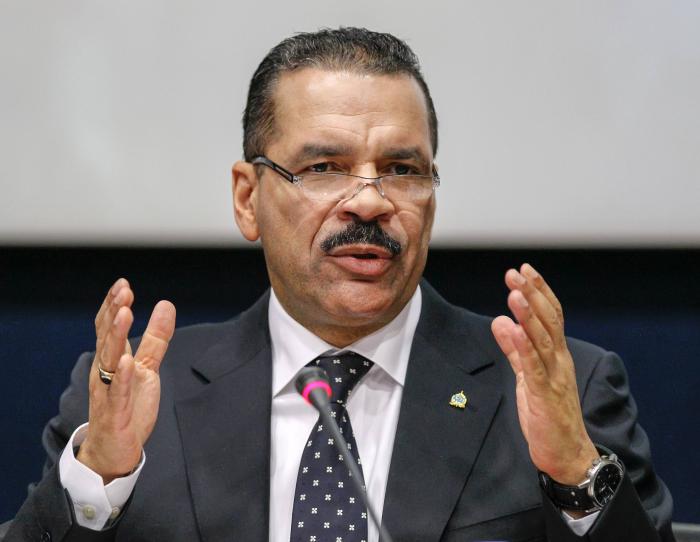Phuket Gazette World News: Malaysia Air Chief denies missing flight tracked to Malacca Strait, investigates cockpit visit by Phuket tourists

PHUKET: Malaysia’s air force chief has denied saying military radar tracked a missing Malaysia Airlines jetliner over the Strait of Malacca, adding to the mystery surrounding the fate of flight MH370, which vanished on Saturday with 239 people aboard.
A massive air and sea search now in its fifth day has failed to find any trace of the Boeing 777, and the last 24 hours have seen conflicting statements and reports over what may have happened after it lost contact with air traffic controllers.
Malaysia’s Berita Harian newspaper on Tuesday quoted Air Force chief Rodzali Daud as saying the plane was last detected by military radar near Pulau Perak, an island in the strait between the Malay Peninsula and the Indonesian island of Sumatra, at the northern end of the Strait of Malacca, at 2.40 a.m. on Saturday, hundreds of kilometers off course.
“I wish to state that I did not make any such statements,” Rodzali said in a statement on Wednesday. The air force chief said he had merely repeated that military radar tracking suggested the plane might have turned back.
The statement follows reports by the Malay-language Berita Harian newspaper quoting Air Chief Rodzali saying that military radar last detected the plane.
Aviation authorities had earlier said that the plane had vanished about an hour into its flight over the South China Sea, between Malaysia’s east coast and the southern coast of Vietnam.
A search involving nearly 100 ships and aircraft from 10 countries has failed to turn up any signs of the jet liner in the South China Sea.
Rodzali’s account intensified the mystery of what happened to Flight MH370, which disappeared from radar early Saturday after taking off from Kuala Lumpur bound for Beijing.
The pilots did not send any distress signals and the plane’s computer did not signal that there were any technical problems to ground control.
A massive search operation for the Malaysia Airlines Boeing 777-200ER has so far found no trace of the aircraft or the 239 passengers and crew.
Malaysian authorities have said previously that Flight MH370 disappeared about an hour after it took off early Saturday from Kuala Lumpur bound for the Chinese capital, Beijing.
But a senior military officer who has been briefed on investigations told Reuters the aircraft had made a detour to the west after communications with civilian authorities ended.
“It changed course after Kota Bharu and took a lower altitude. It made it into the Malacca Strait,” the officer said.
The Strait of Malacca, one of the world’s busiest shipping channels, runs along Malaysia’s west coast, while Kota Bharu is on the northeast coast.
Such a detour would appear to undermine the theory that the aircraft suffered a sudden, catastrophic mechanical failure, as it would mean the plane flew at least 500 km (350 miles) after its last contact with air traffic control.
The plane’s transponder and other tracking systems were either shut off or not functioning around the time that communications with air traffic control ended. That would have prevented so-called secondary radar used by civilian authorities from identifying it, but not primary radar used by the military.
After the comments from the officer, a non-military source familiar with the investigations said the reported detour was one of several theories and was being checked.
But a spokesman for the Malaysian prime minister’s office said in an interview with the New York Times that senior military officials told him there was no evidence the plane recrossed the Malaysian peninsula, only that it may have tried to turn back.
“As far as they know, except for the air turn-back, there is no new development,” said the spokesman, Tengku Sariffuddin Tengku Ahmad.
In the absence of any concrete evidence to explain the plane’s disappearance, authorities have not ruled out anything. Police have said they were investigating whether any passengers or crew on the plane had personal or psychological problems that might shed light on the mystery, along with the possibility of a hijacking, sabotage or mechanical failure.
“Maybe somebody on the flight has bought a huge sum of insurance, who wants family to gain from it or somebody who has owed somebody so much money, you know, we are looking at all possibilities,” Malaysian police chief Khalid Abu Bakar said at a news conference.
“We are looking very closely at the video footage taken at the KLIA (Kuala Lumpur International Airport), we are studying the behavioral pattern of all the passengers.”
The airline said it was taking seriously a report by a South African woman who said the co-pilot of the missing plane had invited her and a female travelling companion to sit in the cockpit during a flight two years ago, in an apparent breach of security.
“Malaysia Airlines has become aware of the allegations being made against First Officer Fariq Ab Hamid which we take very seriously. We are shocked by these allegations. We have not been able to confirm the validity of the pictures and videos of the alleged incident,” the airline said in a statement.
The woman, Jonti Roos, said in an interview with Australia’s Channel Nine TV that she and her friend were invited to fly in the cockpit by Hamid and the pilot between Phuket, Thailand, and Kuala Lumpur in December 2011. The TV channel showed pictures of the four apparently in a plane’s cockpit.
Stolen passports
The fact that at least two passengers on board the missing flight had used stolen passports has raised suspicions of foul play. But Southeast Asia is known as a hub for false documents that are also used by smugglers, illegal migrants and asylum seekers.
Interpol Secretary General Ronald Noble named the two men as confirmed by Iranian authorities as Seyed Mohammed Reza Delavar, 29, and Pouria Nourmohammadi, 18. They had entered Malaysia using their real passports before using the stolen European documents to board the Beijing-bound flight.
“The more information we get, the more we are inclined to conclude it is not a terrorist incident,” Noble said.
The two Iranians, who started their trip in Doha, had swapped their passports in Kuala Lumpur and used stolen Italian and Austrian passports to board the airliner, he told reporters at Interpol’s headquarters in Lyon.
“We know that once these individuals arrived in Kuala Lumpur on the 28th of February they boarded Flight 370 using different identities, a stolen Austrian and a stolen Italian passport,” he said.
Interpol is working with member states to follow all leads including “terrorism, organized crime, illegal movement of people, whether in the form of human trafficking or smuggling”, Noble said.
Making public the names of the two individuals listed on the Iranian passports might compel family and friends to offer tips that could allow authorities to exclude terrorism theories.
“By doing this, eventually, with more and more evidence, we’ll able to exclude they were involved in conduct that might have involved the plane to disappear, and focus on eliminating the human trafficking ring that allowed them to travel.”
The Malaysian police chief, Khalid, said the younger man, who he said was 19, appeared to be an illegal immigrant. His mother was waiting for him in Frankfurt and had been in contact with authorities, he said.
“We believe he is not likely to be a member of any terrorist group, and we believe he was trying to migrate to Germany,” Khalid said, though he said he could eliminate the possibility of a hijacking until the investigations were completed.
In Washington, the director of the CIA in Washington said intelligence officials could not rule out terrorism as a factor. “You cannot discount any theory,” CIA Director John Brennan said.
I
— Phuket Gazette Editors
Latest Thailand News
Follow The Thaiger on Google News:


























